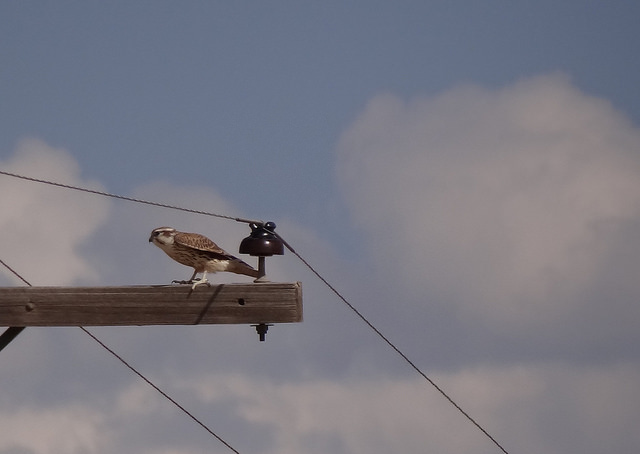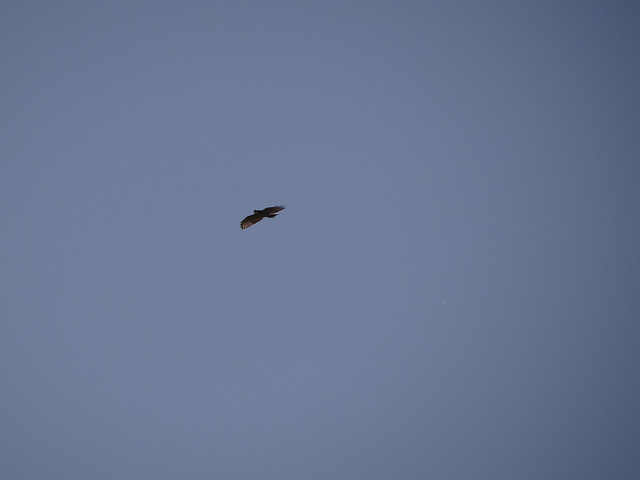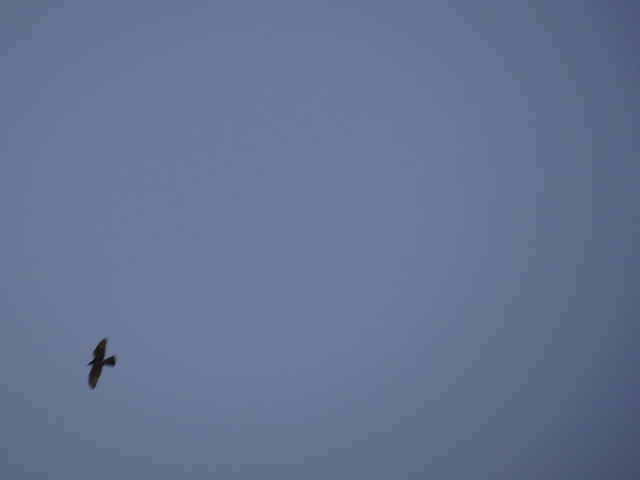
I never sleep well on the first night of a field trip: too preoccupied, too excited, too ready to go. This first night of our Linnaean Society visit to the western Great Plains was no exception. I was still awake at 1:00 am local time, and finally just gave up when the clock said 4:45. I fueled the vehicle, parked it out front, showered, finished packing, had a not overly wonderful hotel breakfast, and wrestled our suitcases into the van. And we were off.
Our first stop was the beautiful Wyoming Hereford Ranch, where the heat and the strong winds managed to depress activity. All the same, we enjoyed our first encounters with lots of the species we can expect to see again this trip, including Townsend’s solitaires, Audubon’s and orange-crowned warblers, and Swainson’s hawks. Our very best bird of the stop, and of the day, and quite possibly of the entire week ahead, was a more typically eastern species, a neat crisp juvenile broad-winged hawk that was sticking to the willows along the creek. Naturally, I forgot to try to take photos when the bird was closest and most obliging, but still came up with a couple of identifiable images.

Identifiable, that is, if you know what the picture is supposed to be of.

A dusky flycatcher was a good find, too. But the heat and the wind and the clock drove us on to Pine Bluffs, where we had a good lunch at the 307 before birding the rest area. Traditionally a good spot, today it produced a total bird list of one species, and that not even native (guess). We cut our losses and crossed over to the Nebraska side, where our luck continued: a lark sparrow, a handful of mountain bluebirds, and that was disappointingly it for what is often one of the most exciting little birding corners in the state.
Rather than give up completely and hightail it to Scottsbluff, we decided to drive north on Stateline Road, a good decision. Soon we started seeing sparrows, vesper sparrows by the hundreds along with smaller numbers of clay-colored sparrows; common, even humdrum out here at this season, those are birds that I see only a couple of times a year in New Jersey. And they’re heartbreakingly beautiful to boot. It was challenging, as usual, to get everyone equally good views from the confines of the van, but there were enough birds that eventually they got sloppy, perching on fences and sunflowers and roadsides to let all of us enjoy them.
The most abundant bird, as expected, was another species I tend to see in only smallish numbers in New Jersey. Horned larks flushed 50 and 100 at a time from the roadsides, and finally one little gang feeding on the newly graded gravel had with it half a dozen smaller birds with big, fat bills, chestnut shoulders, and stunningly white tails. I firmly expected to see McCown’s longspurs this week, but maybe not on our first full day of birding, and maybe not in such great close views right away. Numbers were small — a dozen, perhaps a few more — but we should make up for that tomorrow and the days after.
Where there are longspurs, there are usually ferruginous hawks, but that fine plains buteo eluded us today. Instead we made do with three prairie falcons, two in flight together and the sweet little creature in the photo at the top of this entry; it would have been a lifer for some in our group had it been the first of the three, but in any case was exactly the close and lingering view all of our group were hoping for.
As we turned east to return to pavement, I spied a tiny bit of sheetwater at an intersection, where longspurs were coming in to drink and bathe. One of them obligingly perched on a fence next to the van, confirming that the flock was mostly chestnut-collareds, one of the species I had warned everyone not to expect to see. There’s a special pleasure sometimes in being wrong.
We’d had a surprisingly good afternoon’s car birding, but there was one more place I wanted to check on the way to Scottsbluff. The nature center at the Wildcat Hills almost always has a bird or two to look at, so we pulled in to see if we might pad the list somehow or other. It worked. The most abundant birds in the pines around the building were red crossbills; spotted towhees more or less covered the ground under the feeders, joined by my first Gambel’s sparrow of the autumn. And there were two surprises.
The first was provided by Brian, who showed me a picture on his camera of the big gray finch with white wing patches he had just photographed — evening grosbeak! And the second was provided by a big gray finch with white wing patches — the real thing. It had been years since I’d seen one in Nebraska, and this bird’s presence raises my hopes even higher for tomorrow. If it’s half as good as today, we’re in for some fun.

